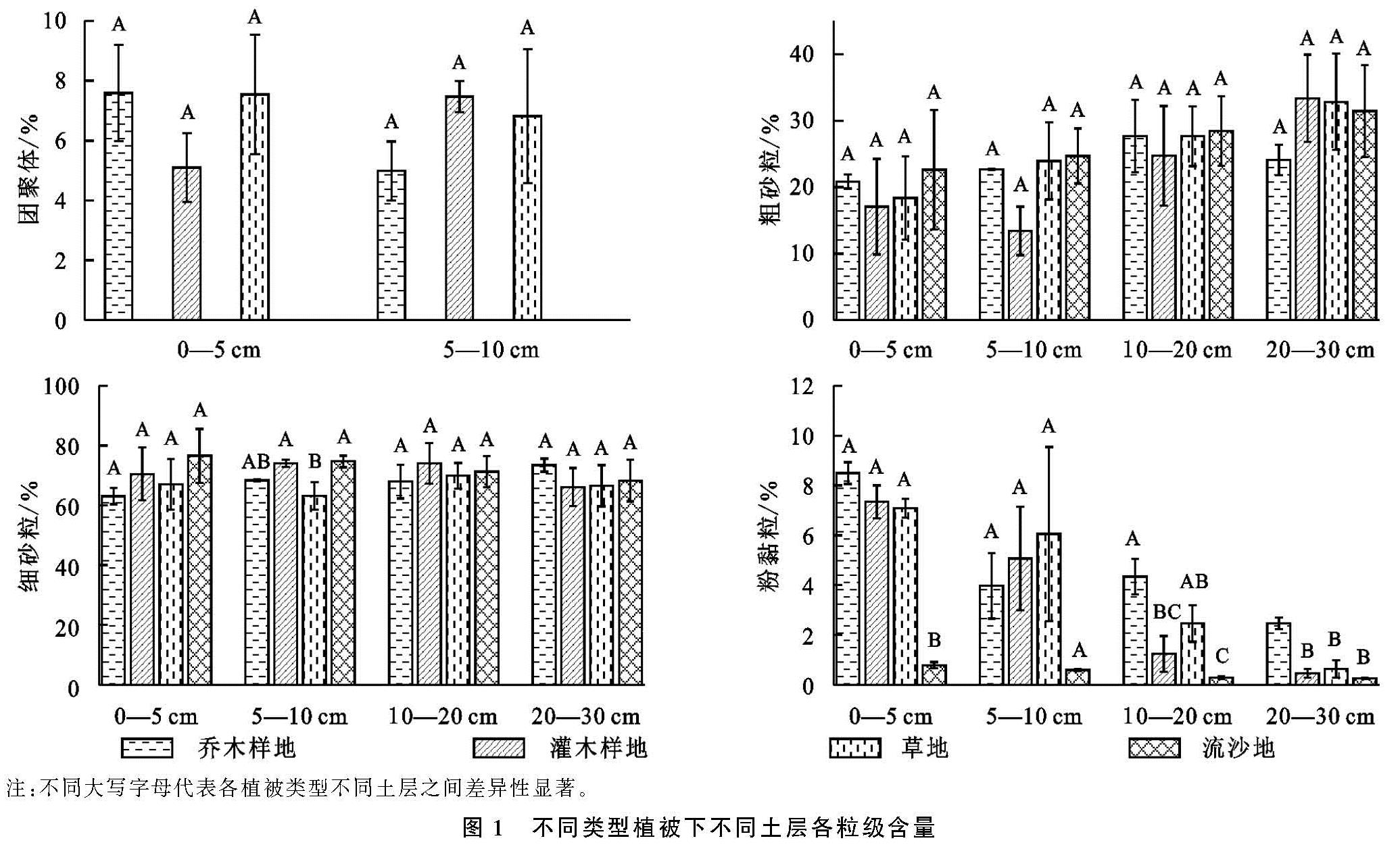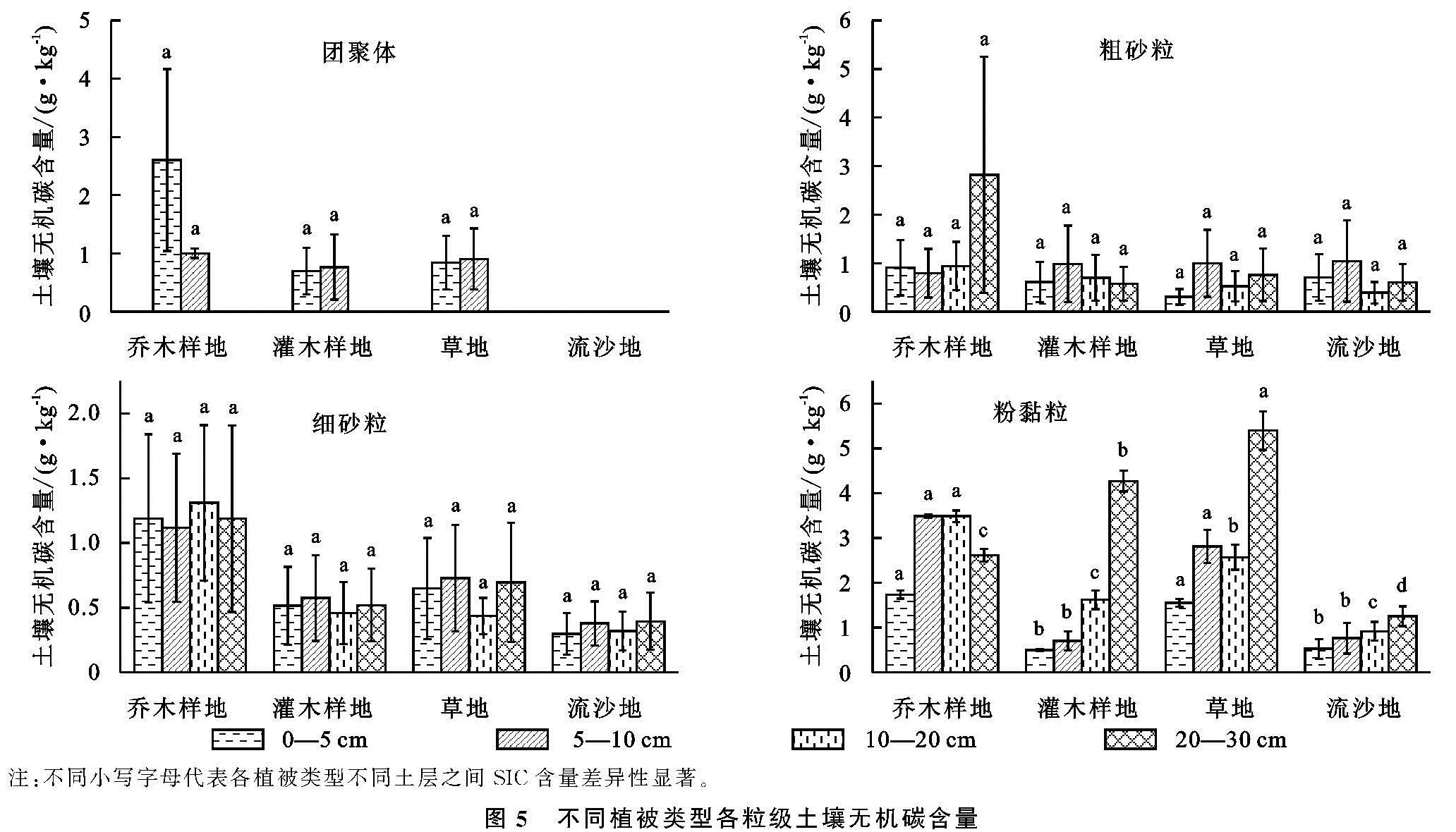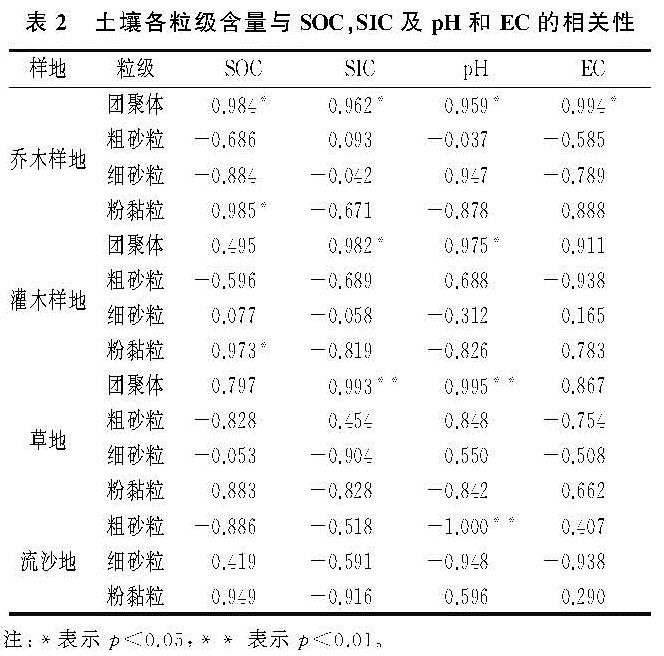3.1 土壤理化性质与土壤颗粒组成的相关关系
团聚体含量与有机碳含量密切相关(表2)。不同恢复模式对土壤团聚体的形成和SOC含量的影响具有一定的差异[23]。各样地土壤团聚体含量与SOC含量之间的相关关系说明植被类型的改变对土壤团聚体的形成影响不大,这与李秋嘉等[24]的研究结果不一致,可能跟恢复时间较短有关。灌木样地中,粉黏粒含量与有机碳含量之间呈显著正相关关系,而草地和乔木样地两者相关性不明显。相关研究表明细颗粒含量与SOC含量存在显著相关性[25],也有研究表明两者之间并无严格的对应关系[26]。Callesen等[27]认为粉黏粒含量是影响有机碳含量的关键因素,它通过吸附有机碳从而形成稳定的有机—无机复合体,能够抵抗微生物的分解并减小矿化风险,因而具有较强的固碳能力,这也是粉黏粒组分在土壤中含量较少但是含碳量却较高的原因。各样地粗沙粒含量与有机碳含量呈负相关关系,表明粒径大的土壤颗粒不利于有机碳的累积。
与流沙地相比,各粒级SIC含量也表现出一定的差异。乔木样地SIC含量增幅较大,而其他样地之间差异不明显,这可能与有机碳的含量有关[7],因为SOC的分解是SIC的主要成因之一[28]。各样地各粒级含量与无机碳含量的相关关系说明植被恢复过程中,团聚体含量与SIC含量关系密切。此外,各粒级组分含量与pH值之间相关性均在团聚体组分达到显著水平,魏彬萌等[29]的研究也指出土壤pH与团聚体之间存在一定关系。团聚体组分只在乔木样地与电导率的相关关系达到显著水平,其他样地各组分与电导率之间相关性均不显著。即pH和电导率均不是影响土壤各粒级组分含量的主要因素。
表2 土壤各粒级含量与SOC,SIC及pH和EC的相关性
3.2 植被恢复对土壤固碳的影响
固沙植物可以通过增加地面粗糙度来降低风蚀作用,同时更有利于大气降尘的截留。而且随着植被的恢复,枯落物不断累积,植物根系分泌物增加,土壤微生物活动逐渐活跃,有机物积累和矿化分解过程加快,土壤性质逐渐发生改变,从而导致土壤各粒级的含量发生改变[30]。各样地粉黏粒含量与流沙地相比均有所增加,砂粒含量均有所减少,土壤质地随着植被恢复呈逐渐细化的趋势,且在垂直方向上表层质地比下层质地更细,这与热依拉等[30] 、李少华等[31]的研究结果一致。研究区乔木林郁闭度较高,林下下生物量较少,土壤母质的风化作用较弱,而草地的地表、地下生物量较大,更加有利于土壤母质的风化,且草本植物捕获的大气降尘能随着枯落物直接进入土壤中[1]。所以,相同恢复年限的草地团聚体含量及其有机碳含量比乔木林地高,更有利于风沙土的改良,这与华瑞等[32]的观点相一致。
SOC在各样地均出现明显的表聚效应,乔木样地SOC含量的增幅比灌木样地和草地更大。相对于乔木,土壤微生物更容易分解利用灌木和草本植物的枯落物,而枯落物是SOC的主要来源[14],所以乔木样地SOC含量较高。各样地SIC均无明显的表聚现象,可能是疏松的表层结构有利于无机碳向下层淋溶迁移所致[7]。各样地SIC含量具有一定差异,说明SIC含量受植被类型的影响较大。
SOC和SIC含量的一致变化趋势说明两者的累积速率和相互转化关系较为密切[27]。以往研究中,干旱半干旱地区SICD远大于SOCD[33]。而灌木样地的SICD小于SOCD,可能与恢复时间有关。土壤碳酸盐的转化周期较长,累积过程较为缓慢,而研究区各样地恢复时间较短,从而导致SICD低于SOCD[22]。
3.3 各粒级土壤有机碳与无机碳对总碳的贡献率
相关分析表明:团聚体有机碳含量与总有机碳含量呈极显著正相关关系,粉黏粒有机碳对总有机碳的贡献率最为显著。说明SOC含量主要受到团聚体和粉黏粒组分的影响。因为团聚体的复杂结构能够有效保护有机碳不被分解和矿化,粉黏粒的吸附作用也有利于有机碳的累积。
各粒级SIC含量与总SIC含量之间无显著相关关系,且各粒级无机碳对总无机碳的贡献率均不显著。







